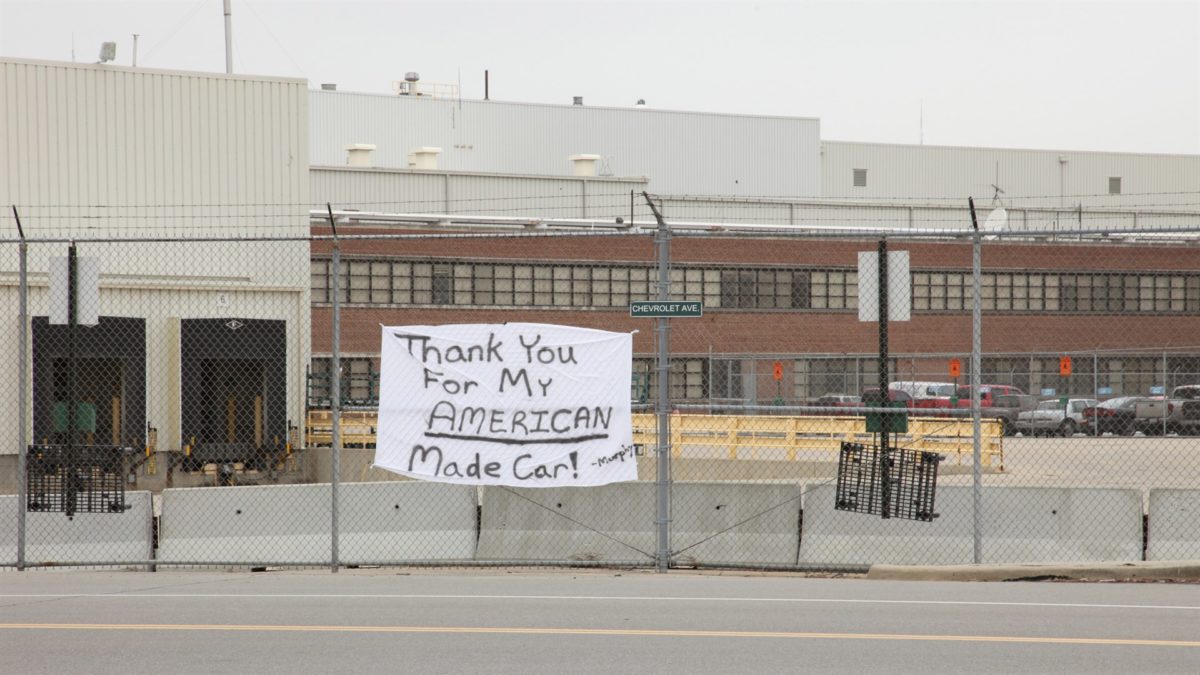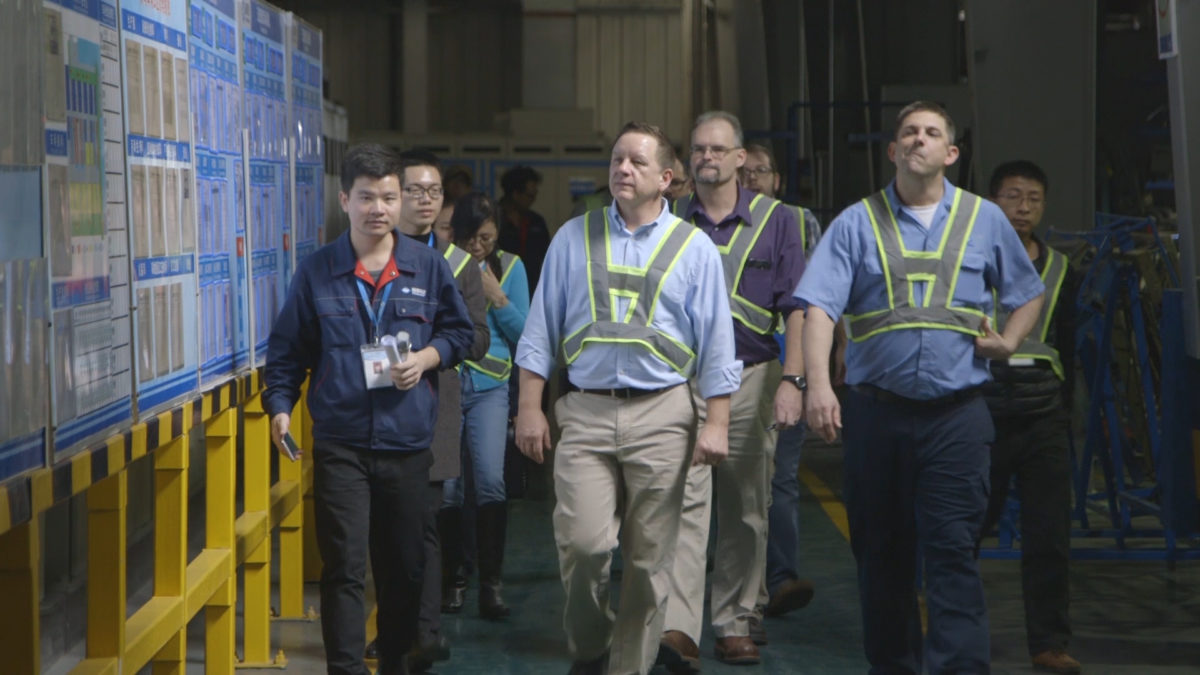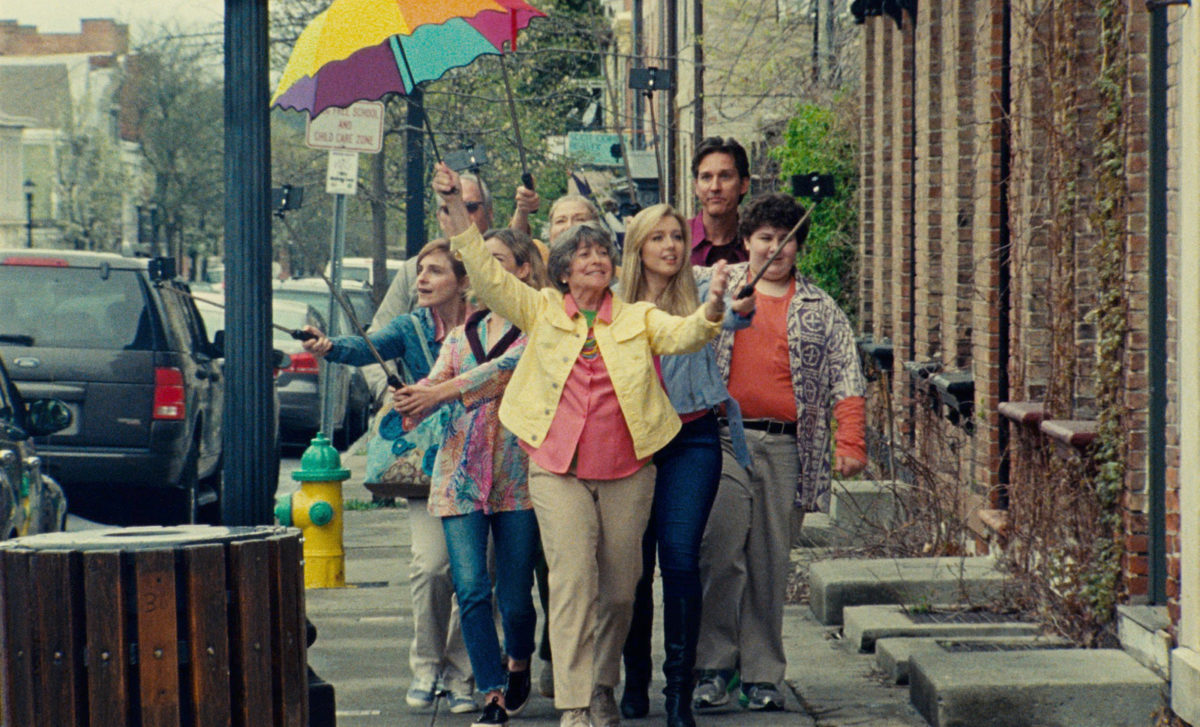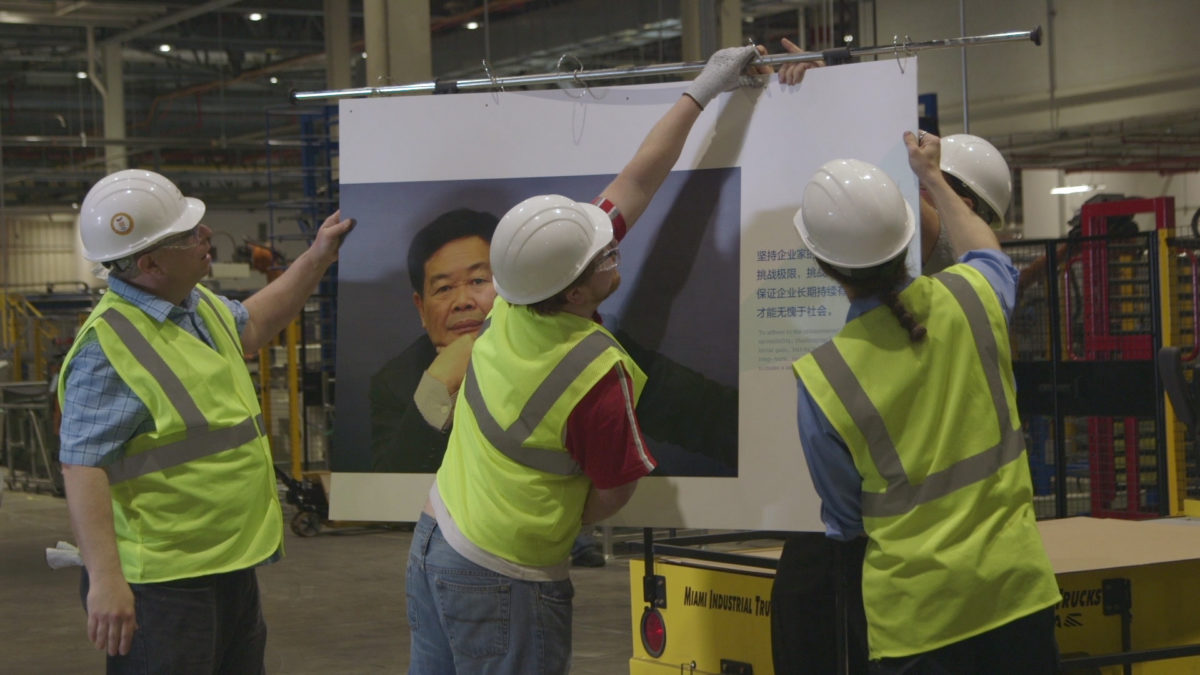A key quality of the moving image career of Julia Reichert is that it isn’t monolithic; in the sense that bar one film, Emma and Elvis (1992)—an outlier as a fiction film made by one of the founding figures of American independent documentary film—her filmography is free of sole directorial credits, ranging from her debut in 1970 to American Factory (2019), her latest feature. Instead she is a shining example of cinema as a uniquely collaborative medium, co-directing mainly with filmmakers Jim Klein (in the 70s and 80s) and Steven Bognar (from the 90s to the present). It is more than appropriate, or even a natural condition, given that the majority of her filmography is concerned with the struggle to define work as an equalitarian collective endeavour. That our working hours are nearly synonymous with our waking lives, that they fuel the engine of society, makes work a hotly contested site of meaning, fought over by both the wealthy, who wish to confine and define work in a fashion which will maximise their profits ergo their power, and by the multitudes who make up labour and those who believe in it as a force for a possible utopia.
Her first two ventures into this area, with Klein, are Union Maids (1976) and Seeing Red (1983). Two films that situate themselves firmly on the side of the workers, with the former fielding the testimonials of those women who were on the frontlines of the 1930s labour movement while the latter speaks with those who carried the card of the American communist party. Collating accounts that date from the 30s onto the late 50s, both films mark and record forgotten histories, though veer away from being strictly observational. They dodge the pitfalls of hagiography by those participants open to self-criticism but also through Reichert’s questioning, which exposes the fault lines in the movements of which they are ostensibly supportive. So, racism and sexism within the labour movement are discussed in Union Maids and then the same issues again in Seeing Red in addition to the party’s association, or even subservience, to the Soviets. The eventual consequences of which being that the party’s psyche was dealt a death blow when Khrushchev formally repudiated Stalin and revealed the massive body count mounted under his policies.
While Reichert’s career would take other avenues, she would return to the subject of labour, now with Steven Bognar, in 2008’s The Last Truck: The Closing of a GM Plant, a 40 minute funeral dirge commissioned and broadcasted by HBO. Instead of being analytical with the benefit of hindsight, and with subjects with decades of rumination under their belts, it offers a reflection that is almost entirely emotional. The Last Truck tracks the days leading up to, and immediately after, the closing of the Genera Motors plant in Moraine near Dayton, Ohio (the city which Reichert and Bognar call home). The laid off workers, in single or group interviews, mull over the loss of a profession that besides the years of friendship gained and an equal amount of sweat and time shed, sustained a union-fought—and won—blue-collar middle class existence that for many will prove impossible to maintain in the future. Like her previous films, Reichert and Bognar stay away from those in charge who pulled the plug and instead talk to the boots on the ground in locations that accentuate the sense of loss. No longer in spaces that hinge on the anonymous, we see these men and women in their homes, which they have scrupulously built and will most likely eventually lose. We see them at the bar, which when it is met with loss is a setting that is innately elegiac as it allows the workers to come together to express their frustration and sorrow while drowning it. And of course there is the factory itself, which Reichert and Bognar allow us to see selectively, mainly as the car park, which, like the bar, becomes a zone of commiseration, where we see workers drag out and load their toolkits and grieve; and a few glimpses of the assembly line itself, where as per the title the passing of its final production is marked. Otherwise it is seen from the far distance, like a mountain shrinking in the rear-view mirror. Or rather, as one interviewee’s analogy puts it, like a dragon, slumbering under an overcast sky.

A few years later and the dragon will live again. Though no longer under the aegis of a collapsing economy and a company on the downturn. The victim of a downsizing that occurred because of and despite massive bailouts is resurrected and transformed in a time in which globalized corporate power has reached a peak and both the will and the capacity for organized labour to defend itself and its gains are at an all time low. In the opening of Reichert and Bognar’s American Factory (2019), we see how in 2014 the plant was bought and renovated for operation by a Chinese car glass manufacturing company called Fuyao, who are in the midst of a worldwide expansion. As renowned local filmmakers with a long history exploring the subject, Reichert and Bognar were brought in by the company to film the process. Instead they rejected the owner’s funding support but kept to the offer of open access, flitting between the factory floor and the head office in order to document the ensuing culture clashes, between Chinese and American executives as they wrestle over the factory’s identity as American, Chinese or vaguely internationalist; and between a predominantly Chinese supervisory team—workaholic and taught to be paternalistic of their American underlings and suspicious of union activity—and a predominantly American workforce, many of whom worked under the plant’s previous regime and so have to reckon with stepping down to lower pay, longer hours, harsher deadlines and a more laissez affaire attitude towards workplace injuries; and then in the film’s second half—when the workers start to plan and canvas for a vote to form a union—between a belief in greater worker autonomy and unity, and neoliberalism bent on stripping away that power in favour of a regimented yet atomised workforce.
Focusing on the activities and opinions of those on the top for the first time, in addition to the workers, American Factory is an elegantly bifurcated film in how flits between opposing groups/people and even tones. The strongest example of this is a subplot featuring two linked case studies, Rob Haerr, a furnace supervisor, and Wong He, a furnace engineer. Woven throughout the film we see both, separately, express their thoughts on working for Fuyao. They also talk about their lives before the company, their view on the poor relations between those native Ohioans on the line and the Chinese workers who have been brought in, and the effect the whole experience has had on their personal lives and general outlook. Though both clearly work closely together, it becomes a tale of unrequited love, of sorts, whose origin in part comes from differing conceptions and expectations of work. Haerr, a more open personality, talks of the relief of coming back into this kind of work after many listless years of unemployment and more precarious jobs. He places great importance on his relationships with other workers and singles out Wong as a newfound close friend. Yet Wong—a Fuyao employee since the age of 18—doesn’t mention Haerr, and while he speaks of his American colleagues in a far less disparaging tone than what his compatriots dish out there is a distance and even a hint of superciliousness to his compliments. The idea of a successful workplace for Wong translates to company profit bringing a sense of pride; his allegiance is to the company as a borderline abstract entity—a mass pursuit but one where everyone is absorbed into a strict hierarchy—rather than as a community of individuals who are on equal footing. While for Haerr what is important is his own welfare and a strong camaraderie. Ultimately it is the former definition that wins out, with the vote for organizing failing and, after years of falling short of quotas, downsizing, with Haerr among those laid off.
This disjunction, between two work cultures and in the struggle between a workface and a corporate class that appropriates it, generates an absurdist tone that is new to Reichert’s repertoire. It is there for example in the contrast between the training the American workers receive, which is fairly bland and straightforward, at least at first, and full of your typical clichéd corporate jargon involving productivity and team building, and the de facto dummy’s guides to America the Chinese workers are presented with, which paints its populace, their co-workers, as child-like layabouts who need regular carrot and stick treatment in order to be prodded and coaxed into becoming more amendable to overtime. This theory, with a bias towards the carrot end, is put into bizarre practice when in response to slower than expected production, several American supervisors are chosen for a fact-finding mission to the company headquarters in China. Though perhaps a little overegged by a jauntily light hearted score, this leads to the film’s funniest sequence, as these tall, burly and heavily tattooed men, all seemingly fixed with a slight deer-in-the-headlights look by their new surroundings, are sent on a factory tour. It starts with one of them trying to put on a Hi Vis vest, which he accomplishes save for one of the straps, which comes loose, unnoticed. This man with his strap, a flapping error, is the one hitch in what is otherwise a pitch perfectly organised display of corporate power and vacuity, and how it adopts and re-appropriates proletarian culture. And so he remains at the centre of the frame and our attention, as a series of elliptical cuts has them all marching from head office to the assembly line where they are led to view the factory’s morning calisthenics. Here Reichert & Bognar cut between a wide shot of these Americans, standing shifting uneasily, and shots of the Chinese workers, all comparatively slim and short, responding and moving robotically.

The dissonance reaches a peak with the Fuyao’s annual ceremony-cum-celebration, essentially an elaborate show that uses child performers, pop songs written for and sung in praise of the company’s achievements and the actual wedding of employees, to make Chinese culture and society streamlined and transformed into the corporate kitsch that has appropriated it. After representing ‘America’ by barrelling on and across the stage to the tune of YMCA, one of the visitors departs from his group and leaves the hall temporarily because he is moved to tears by the coming together of cultures. “We are all one”, he says, by way of explanation, to a concerned performer, who, slightly confused, responds with “Yes. One people. One company.” It is an odd moment where an expression of genuine emotion sneaks out of neoliberal co-opting of multiculturalism and blue-collar culture before it is assimilated again.
Comic is the tone chosen, not just discovered and emphasized, by another American independent who’s dealing with a grassroots culture that is under duress and being appropriated. Patrick Wang is similarly interested in how old and radical practices and approaches to labour contend with their commodified successors. He makes fiction instead of documentary and for his third feature, A Bread Factory, instead of heavy industries, he looks at the making and exhibition of art. I should say maybe his third and fourth feature, for A Bread Factory is a four-hour work split into two equal parts (respectively titled Part One: For The Sake Of Gold and Part Two: Walk With Me A While), both of which are set in a fictional upstate New York town called Checkford, a microcosm of the small, regional city (like Reichert’s Dayton) in that its cultural life rests largely upon a functioning arts centre which at its best can cultivate a mushrooms-in-the-dark singularity in artists who have come of age far from any major cultural centre. The name of the one in Checkford is in the title and, pointedly, comes from the building’s blue-collar and collective origins; a mass producing bakery operational during the town’s bygone industrial age. Now it is the town’s cultural heart rather than its economic one. A community space for all ages which fields talks, workshops, screenings, poetry readings and theatre (the last one is especially key as a subplot involving the preparation and then performance of Euripides’ Hecuba recurs the full length of the film’s four hours). All of this has been lovingly and scrupulously maintained for decades by Dorothea (Tyne Daly) and Greta (Elizabeth Thompson). Life partners not only in love but in work and activism as the film beautifully sums up at the onset. Showing two lives life spent together by cutting from a shot of the two women when they were young—wielding placards in black and white, blurred—to a shot, near identically staged, of the same women, older but still at it, in 16mm with the bright, pastel colours which will remain the film’s palette.
The narrative in the first part comes piecemeal, illustrating the town’s many denizens, their relationships, passions, foibles and how one way or another they are connected to The Bread Factory, whose events we see in detail. An arch narrative comes in the form of an existential threat. A performance and video art duo, supposedly, from China called Mayray have arrived in Checkford with a coolly salacious publicity agent and plans to set up their own arts centre in tow. Its construction depends on funding from the local town council, which if won will mean The Bread Factory will lose theirs and therefore will be rendered effectively defunct. Part One then builds to a courtroom drama style climax in a community vote where both sides make their case.

It would have been easy to erect a strict dichotomy between the classics-informed community-serving activities of The Bread Factory and the commercialized post modernism of Mayray, who in their excessively sculpted, anonymous personas (the workings of which are explored more in Part Two) render themselves overtly constructed, authorless, and non-collaborative, like a post-sex pistols Malcolm McLaren project minus the dodgy sexual politics—or even just sex period—and that discernible Svengali-like presence. Their art is on the face political but their intent and targets obscure and ironic in the extreme, to the point of insipidity, as in one piece that we see where they leap on tables, protesting the hierarchy of furniture. They function then as parody of how the upper echelons of commercial art imitate a movement such as modernism’s historic uses of distance and focus on formalism—with their rigidly syncopated performances—but present them without a single iota of the artistic and political daring that was originally felt when these techniques brought the shock of the new. Yet The Bread Factory is not taken dead serious as a point of contrast, as it is in some ways a jumble of caricatured art types, such as Janeane Garofalo as a hyper-aggressively committed independent filmmaker, seen browbeating a workshop of preteens because she feels they are selling themselves short; and Jeremiah Wenutu as a sensitive poet, who is out like a light after an overload of praise; or most predominantly Brian Murray as Sir Walter, a geriatric English actor of the stage who speaks with an outraged configuration of classical diction—he finds his commercial counterpart in Chris Conroy who’s supposedly playing Trooper Jaymes, a dumb as bricks Hollywood actor drafted in to help promote Mayray. That he is meant to be a big movie star doesn’t quite work, but his blandly handsome appearance—including a square cut jaw—makes him look more like a regular on a CW show or a latter day porn star, which is a better analogy given the film’s conception of overly commodified art as a person or movement with its edges shorn and airbrushed until it’s a hollowed out receptacle of clichéd signifiers.
These parodies helpfully stave off the rot of self-seriousness, but that Wang ultimately values the practices and beliefs of Dorothea, Greta and their friends more is evident in the detail devoted to how they work through and with art. The staging of Hecuba draws the most time and attention, the slightly troubled course it takes to the proscenium reveals how much its making is steeped in the personalities of the people involved. How in the theatre there will be unexpected casting changes that will thus transform the players’ and directors’ conception of the play; how there will inevitably be disagreements over line readings and meanings; how the unexpected or the decisions individuals take in their personal lives and the passage of time will inevitable steer the direction of a production. Wang not only observes but registers how these obstacles and changes are building to something by a process of slowly progressing forward himself, formally speaking. We see the first rehearsals not only from the perspective of a future audience but from high up in the auditorium. From which height the production looks distant and ill-formed. But as the film travels from Part One to Part Two and as the play comes closer to realization and its final shape, the camera tiptoes its way down until its on the stage with the players, where choices made with the performances and staging become more detailed and concrete. It’s a process that Mayray are never subjected to, because we never to get to see how the sausage is made. Their art is seen only in its finished state and with the supposed intentions and meaning declared with the vacuity and interpretation-excluding finality of publicity statements. Their concoctions of art-speak are a million miles away from a simple scene in Part Two, where Dorothea and Greta (who is to play Hecuba) discuss the latter’s anxieties over how she should interpret her character, while they cosy up in their living room. It is a beautiful scene not only because it is such an adroit depiction of a relationship dynamic that has been in ferment for decades, but also because it presents art as alive. As something that is not only ripe for restaging but open to change, to new ideas—even though in this case it is literally as old as antiquity. Made by practitioners who are not backed by massive budgets with pruned and vetted reputations. It is enough that they have a surfeit of belief that what they are doing is worthwhile and that they have the canniness and reserve to pull it off.
Whether they do pull it off or not is left unclear. The Bread Factory ends bittersweet, with individual relationships reaffirmed but the state of community-led arts in the town on a knife edge, while American Factory closes with more pessimism, with the hopes of establishing a union led workplace dashed. What makes these films invigorating though and in part ties Reichert & Bognar and Wang together is the importance placed on the attempt. That to try, at all, to form a union or maintain a non-profit art space that is genuinely open to the whole community, in a world, and particularly a nation, dominated by the cult of the individual, is evidence enough of the stubborn subsistence of the Utopian collective endeavour. A spirit that despite its uncertain future, these filmmakers have declared still matters through their focus on the guile and grit it has and still does inspire.
